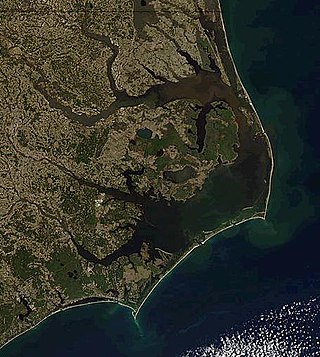Related Research Articles

Canadian raising is an allophonic rule of phonology in many varieties of North American English that changes the pronunciation of diphthongs with open-vowel starting points. Most commonly, the shift affects or, or both, when they are pronounced before voiceless consonants. In North American English, and usually begin in an open vowel [~], but through raising they shift to, or. Canadian English often has raising in words with both and, while a number of American English varieties have this feature in but not. It is thought to have originated in Canada in the late 19th century.

Hyde County is a county located in the U.S. state of North Carolina. As of the 2020 census, the population was 4,589, making it the second-least populous county in North Carolina. Its county seat is Swan Quarter. The county was created in 1705 as Wickham Precinct. It was renamed Hyde Precinct in 1712 and gained county status in 1739.

Smith Island is a collection of three distinct island communities – Tylerton, Rhodes Point, and Ewell, Maryland – on the Chesapeake Bay, on the border of Maryland and Virginia territorial waters in the United States. The island is the last inhabited island in Maryland that is not accessible by vehicle. Most of the islands are eroding due to tidal currents and sea level rise; a study conducted in 2008 by the DNR reported that Smith Island is expected to completely erode by 2100 if no action is taken.
Harkers Island is a census-designated place (CDP) in Carteret County, North Carolina, United States. The population of Harkers Island was 1,207 at the 2010 census. Harkers Island is unincorporated and receives most public services, including law enforcement and public education, from Carteret County. A membership cooperative provides the island with electric and water services. Major industries on the island include fishing, boat building, tourism, and waterfowl decoy carving.

Ocracoke is a census-designated place (CDP) and unincorporated town located at the southern end of Ocracoke Island, located entirely within Hyde County, North Carolina, United States. The population was 948 as of the 2010 census. In the 2020 census, the population had dropped to 797 people.
A vowel shift is a systematic sound change in the pronunciation of the vowel sounds of a language.
Southern American English or Southern U.S. English is a regional dialect or collection of dialects of American English spoken throughout the Southern United States, though concentrated increasingly in more rural areas, and spoken primarily by White Southerners. In terms of accent, its most innovative forms include southern varieties of Appalachian English and certain varieties of Texan English. Popularly known in the United States as a Southern accent or simply Southern, Southern American English now comprises the largest American regional accent group by number of speakers. Formal, much more recent terms within American linguistics include "Southern White Vernacular English" and "Rural White Southern English".
The English language as primarily spoken by Hispanic Americans on the East Coast of the United States demonstrates considerable influence from New York City English and African-American Vernacular English, with certain additional features borrowed from the Spanish language. Though not currently confirmed to be a single stabilized dialect, this variety has received some attention in the academic literature, being recently labelled New York Latino English, referring to its city of twentieth-century origin, or, more inclusively, East Coast Latino English. In the 1970s scholarship, the variety was more narrowly called (New York) Puerto Rican English or Nuyorican English. The variety originated with Puerto Ricans moving to New York City after World War I, though particularly in the subsequent generations born in the New York dialect region who were native speakers of both English and often Spanish. Today, it covers the English of many Hispanic and Latino Americans of diverse national heritages, not simply Puerto Ricans, in the New York metropolitan area and beyond along the northeastern coast of the United States.
North American English regional phonology is the study of variations in the pronunciation of spoken North American English —what are commonly known simply as "regional accents". Though studies of regional dialects can be based on multiple characteristics, often including characteristics that are phonemic, phonetic, lexical (vocabulary-based), and syntactic (grammar-based), this article focuses only on the former two items. North American English includes American English, which has several highly developed and distinct regional varieties, along with the closely related Canadian English, which is more homogeneous geographically. American English and Canadian English have more in common with each other than with varieties of English outside North America.

The Outer Banks are a 200 mi (320 km) string of barrier islands and spits off the coast of North Carolina and southeastern Virginia, on the east coast of the United States. They line most of the North Carolina coastline, separating Currituck Sound, Albemarle Sound, and Pamlico Sound from the Atlantic Ocean. A major tourist destination, the Outer Banks are known for their wide expanse of open beachfront and the Cape Hatteras National Seashore. The seashore and surrounding ecosystem are important biodiversity zones, including beach grasses and shrubland that help maintain the form of the land.
In the history of English phonology, there have been many diachronic sound changes affecting vowels, especially involving phonemic splits and mergers.
Pacific Northwest English is a variety of North American English spoken in the U.S. states of Washington and Oregon, sometimes also including Idaho and the Canadian province of British Columbia. Due to the internal diversity within Pacific Northwest English, current studies remain inconclusive about whether it is best regarded as a dialect of its own, separate from Western American English or even California English or Standard Canadian English, with which it shares its major phonological features. The dialect region contains a highly diverse and mobile population, which is reflected in the historical and continuing development of the variety.
New England English is, collectively, the various distinct dialects and varieties of American English originating in the New England area. Most of eastern and central New England once spoke the "Yankee dialect", some of whose accent features still remain in Eastern New England today, such as "R-dropping". Accordingly, one linguistic division of New England is into Eastern versus Western New England English, as defined in the 1939 Linguistic Atlas of New England and the 2006 Atlas of North American English (ANAE). The ANAE further argues for a division between Northern versus Southern New England English, especially on the basis of the cot–caught merger and fronting. The ANAE also categorizes the strongest differentiated New England accents into four combinations of the above dichotomies, simply defined as follows:
English diphthongs have undergone many changes since the Old and Middle English periods. The sound changes discussed here involved at least one phoneme which historically was a diphthong.
Older Southern American English is a diverse set of American English dialects of the Southern United States spoken most widely up until the American Civil War of the 1860s, before gradually transforming among its White speakers, first, by the turn of the 20th century, and, again, following the Great Depression, World War II, and, finally, the Civil Rights Movement. By the mid-20th century, among White Southerners, these local dialects had largely consolidated into, or been replaced by, a more regionally unified Southern American English. Meanwhile, among Black Southerners, these dialects transformed into a fairly stable African-American Vernacular English, now spoken nationwide among Black people. Certain features unique to older Southern U.S. English persist today, like non-rhoticity, though typically only among Black speakers or among very localized White speakers.

Midland American English is a regional dialect or super-dialect of American English, geographically lying between the traditionally-defined Northern and Southern United States. The boundaries of Midland American English are not entirely clear, being revised and reduced by linguists due to definitional changes and several Midland sub-regions undergoing rapid and diverging pronunciation shifts since the early-middle 20th century onwards.
Tylerton is an unincorporated community located on Smith Island in Somerset County, Maryland, United States. Tylerton can be accessed via a ferry from Crisfield, Maryland. It is a waterman village of 50 residents. Attractions in the community include the Inn of Silent Music and The Drum Point Market, which sells beverages, homemade Smith Island cakes, crab cakes and other Chesapeake Bay specialties. The Chesapeake Bay Foundation's Smith Island Study Center is located in Tylerton.
Walt Wolfram is an American sociolinguist specializing in social and ethnic dialects of American English. He was one of the early pioneers in the study of urban African American English through his work in Detroit in 1969. He is the William C. Friday Distinguished University Professor at North Carolina State University.
In North Carolina, Down East refers to two areas of Eastern North Carolina. The first is the historical group of coastal communities east of Beaufort in Carteret County. The second is anywhere east of I-95 in North Carolina in the coastal plain region.
Natalie A. Schilling is a Professor in the Department of Linguistics at Georgetown University.
References
- ↑ Wolfram & Schilling-Estes 1997 , pp. 1, 69
- ↑ Wolfram & Schilling-Estes 1997 , p. 78: "The verb usages that we have found on Ocracoke help strengthen the connections we've already established between the brogue and other dialects that developed in isolated areas like Appalachia and Tangier and Smith Islands".
- ↑ Subtitles of articles by Walt Wolfram et al. commonly include such a range of terms, such as in "The Story of the Ocracoke Brogue" (1995), "The Invisible Outer Banks Dialect" (1996), "The Distinct Sounds of the 'Hoi Toide' Brogue" (2001), etc.
- ↑ Wolfram & Reaser (2014 :101)
- ↑ Wolfram & Schilling-Estes 1997
- ↑ Wolfram & Schilling-Estes (1997 :123)
- ↑ Wolfram & Reaser (2014 :105)
- ↑ Wolfram & Schilling-Estes (1997 :10)
- ↑ Wolfram & Schilling-Estes (1997 :10)
- 1 2 North Carolina Life and Language Project (2006). Linguistics at North Carolina State: Harkers Island. Retrieved July 28, 2006.
- ↑ Bender, et al. (2004). Linguistic Diversity in the South: Changing Codes, Practices and Ideology. University of Georgia Press:
- ↑ Carlton, Brian (June 24, 2019). "The US island that speaks Elizabethan English". BBC . Retrieved June 24, 2019.
- 1 2 3 4 5 6 7 8 9 10 11 12 13 14 15 16 17 18 19 20 21 22 Schilling-Estes, Natalie (1997). "Accommodation versus Concentration: Dialect Death in Two Post-Insular Island Communities." American Speech, Vol. 72, No. 1 (Spring, 1997). Duke University Press. pp. 16-17.
- 1 2 3 4 5 6 7 8 9 10 11 12 13 14 15 16 17 18 19 20 21 22 23 Howren, Robert (1962). "The Speech of Ocracoke, North Carolina." American Speech, Vol. 37, No. 3 (Oct., 1962). Duke University Press. pp. 163-175.
- ↑ Schilling (1997 :26, 29)
- 1 2 3 Thomas (2006 :12)
- ↑ Wolfram & Schilling-Estes (1997 :53–4)
- ↑ Schilling (1997 :26, 29)
- ↑ Wolfram & Schilling-Estes (1997 :58)
- ↑ Wolfram & Schilling-Estes (1997 :59)
- 1 2 Wolfram & Schilling-Estes (1997 :60)
- 1 2 Wolfram & Schilling-Estes (1997 :61)
- ↑ Wolfram & Schilling-Estes (1997 :62)
- ↑ Thomas (2006 :10)
- ↑ Prioli, Carmine and Martin, Edwin (1998). Hope for a Good Season: The Ca'e Bankers of Harkers Island. John F. Blair Publisher, July, 1998.
Bibliography
- Thomas, Erik R. (2006), "Rural White Southern Accents" (PDF), Atlas of North American English (online), Walter de Gruyter, archived from the original (PDF) on 2014-12-22, retrieved 2015-10-03
- Wolfram, Walt; Schilling-Estes, Natalie (1997), Hoi Toide on the Outer Banks: The Story of the Ocracoke Brogue, University of North Carolina Press, ISBN 0-8078-4626-0
- Wolfram, Walt; Reaser, Jeffrey (2014). Talkin' Tar Heel : How Our Voices Tell the Story of North Carolina. Chapel Hill: The University of North Carolina Press. ISBN 978-1-4696-1437-3.